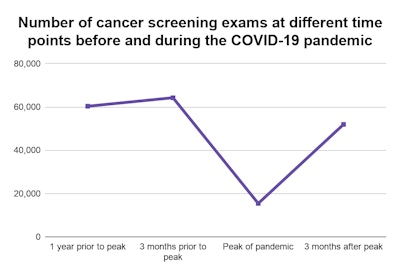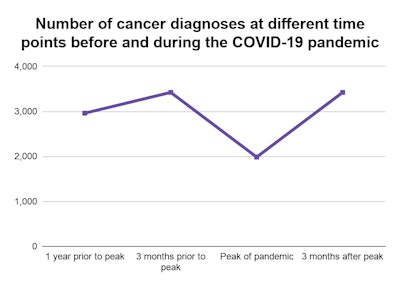
Cancer diagnoses declined by double digits at a prominent Boston healthcare system during the early stages of the COVID-19 pandemic in spring 2020, according to an analysis published on January 14 in JAMA Oncology. Researchers estimated more than 1,400 lesions could have been missed in a three-month period.
The Boston-based research team compared the number of cancerous and precancerous lesions diagnosed through mammography, low-dose CT, and other screening methods during the peak of the pandemic to three other time points. While both cancer screenings and diagnoses plummeted in the spring of 2020, the numbers began to recover in the summer.
"This study reports a significant decrease in the number of patients undergoing screening tests for cancer and in the number of ensuing diagnoses of cancerous and precancerous lesions during the COVID-19 pandemic in one healthcare system in the Northeastern United States," wrote the authors, led by Dr. Ziad Bakouny, a postdoctoral research fellow at the Dana-Farber Cancer Institute, in a research letter.
For their analysis, the authors used screening and diagnosis data from patients at Mass General Brigham. They focused on five types of cancer screening examinations: low-dose CT, mammography, Papanicolaou test (Pap smear), colonoscopy, and prostate-specific antigen (PSA) screening.
The authors calculated the change in cancer screenings and diagnoses for four three-month time periods:
- Peak of the pandemic in New England (March 2, 2020 - June 2, 2020)
- Three months preceding the pandemic (December 1, 2019 - March 2, 2020)
- Same three months of the prior year (March 2, 2019 - June 2, 2019)
- Three months after the peak (June 3, 2020 - September 3, 2020)

A total of 15,453 patients underwent cancer screenings during the peak of the pandemic, which was dramatically fewer than the 60,344 patients screened during the same three months of 2019 and the 64,269 patients screened in the three months preceding the pandemic. The numbers amounted to a staggering decline in the number of screenings, ranging from a 60% decrease for PSA tests to an 82% decrease for mammography.
The findings were similarly grim for cancer diagnoses. A total of 1,985 patients were diagnosed with cancer during the peak of the pandemic, compared with 2,961 people in 2019 and 3,423 people in the three months prior to the pandemic. This accounted for a percentage decrease in cancer diagnoses ranging from a 19% decline in cancer diagnosis for PSA screening to a 78% decline for low-dose CT lung cancer screenings.
In a silver lining, the analysis also showed the numbers of screenings and cancer diagnoses are recovering at the health system. In the summer, 51,944 people underwent cancer screening, and 3,190 cancer diagnoses were made -- numbers that are more in line with prior years.

Based on the data, the authors assumed the health system "missed" the 1,438 cancerous and precancerous lesions during the peak of the pandemic. However, the actual number of "missed" diagnoses could be lower.
The authors couldn't account for people who had moved from the healthcare system, and some data suggest that at least some higher-risk patients were still getting screening during the height of the COVID-19 pandemic.
Notably, the percentage of positive screening tests was higher during the peak pandemic period than at any other time points for all tests but low-dose CT. For instance, the percentage of positive mammography screenings jumped from roughly 2% before the pandemic to 4% during the spring of 2020.



















